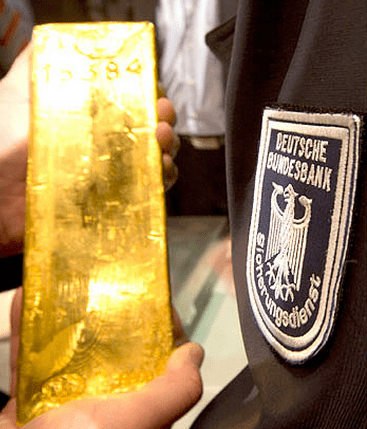One Radio Network was joined by Editor and publisher of the Golden Jackass and the Hat Trick Letter, Jim Willie, who as is stated at the very beginning of the interview, accurately predicted in 2013, the recent Swiss bombshell of unpegging their Franc from the Euro which recent sent the global economic community into shock.
Willie informs us that the “death of the US Dollar process has started”, that Germany worked behind the scenes in encouraging the Swiss to take this action, and then he drops another bombshell, saying that three different sources have indicated that Germany is done with the Euro, done with NATO and is “moving East,” because they are not “going down the sewer” just so they can be “tethered” on a US leash.
Willie warned early on that he was seeing a systemic breakdown coming and now it is here.

Related News:
Bundesbank Announces Repatriation of 120 Tonnes of Gold from Paris and New York Federal Reserve
The Bundesbank, Germany’s powerful central bank, announced very publicly this morning the further repatriation of some of it’s gold being held in foreign locations – namely in Paris and New York with the Bank of France and the Federal Reserve.
“The Bundesbank successfully continued and further stepped up its transfers of gold,” the central bank said in a statement. “Implementation of our new gold storage plan is proceeding smoothly. Operations are running very much according to schedule,” said Carl-Ludwig Thiele, Member of the Executive Board of the Deutsche Bundesbank.
“We also called on the expertise of the Bank for International Settlements for the spot checks that had to be carried out. As expected, there were no irregularities,” Thiele said.
Germany’s gold reserves are the second biggest in the world after those of the United States. The World Gold Council’s latest data shows Germany’s gold reserves at 3,384.2 tonnes today.
The Bundesbank also helpfully provided tables in its press release, presumably in an attempt to create further transparency and understanding of the issue which remains an important one to large sections of the German political and financial class and the public who are concerned about a new Eurozone debt crisis and the fate of the euro.
According to the German central bank’s own data, 1,447 tonnes are stored at the Federal Reserve Bank in New York, 438 tonnes at the Bank of England in London and 307 tonnes at the Banque de France in Paris.
Since the transfers began in 2013, the Bundesbank said it has relocated a total of 157 tonnes of gold to Frankfurt – 67 tonnes from Paris and 90 tonnes from New York.
“In 2014, 120 tonnes of gold were transferred to Frankfurt from storage locations abroad: 35 tonnes from Paris and 85 tonnes from New York,” according to the statement.
This suggests that the Bundesbank continues to struggle to get its gold reserves back from the New York Federal Reserve.
It is important to remember that out of nowhere, the Netherlands secretly repatriated 122 tonnes of the their gold reserves from New York to Amsterdam in 2014.
Since World War II and Germany’s defeat in that war and during the Cold War, Germany’s gold holdings have been kept in the vaults of other central banks – the Banque de France, the Bank of England and the New York Federal Reserve.
Since the global debt crisis and indeed the U.S. and Eurozone debt crisis, there have been grassroots movements for central banks to repatriate their gold to home soil – in order to ensure that it can be used a a reserve asset in the event of a monetary crisis.
Germany expects to have repatriated half of it’s gold reserves for storage in Frankfurt by 2020. Today’s announcement suggests that 23% of the total reserves to be returned to Germany has been delivered.
In its statement the Bundesbank is at great pains to emphasise the authentic nature of the transfer.
“The Bundesbank assures the identity and authenticity of German gold reserves throughout the transfer process – from when they are removed from warehouses abroad until they are stored in Frankfurt am Main.”
“As soon as the gold was removed from the warehouse locations abroad, Bundesbank employees cross-checked the lists of bars belonging to the Bundesbank against the information on the bars removed. Finally, once they arrived in Frankfurt am Main, all the transferred gold bars were thoroughly and exhaustively inspected and verified by the Bundesbank.”
“When all the inspections had been concluded, no irregularities came to light with regard to the authenticity, fineness and weight of the bars.”
However, a curious element to the statement will likely trigger some speculation among those familiar with the gold market. “The Bundesbank took advantage of the transfer from New York to have roughly 50 tonnes of gold melted down and recast according to the London Good Delivery standard, today’s internationally recognised standard.”
Long time observers will note that Germany’s initial request for it’s gold from New York was declined. They were then denied the opportunity to even view their own gold on grounds of “security.”
This led to speculation that the Federal Reserve – who have not had a public audit of gold stocks since 1953 – did not have the gold reserves it was supposed to be custodian of. The immediate melting down of fifty tonnes of gold before it could be publicly audited in Germany will not alleviate these suspicions.
From a wider perspective this story reaffirms the fact that central banks today, the monetary masters of the fiat currencies we use, still view gold as a vital safe haven monetary asset and reserve currency. It also indicates a lack of trust between central banks, a trust which seems to have been further undermined by the chaos created by the apparent unilateral move by Switzerland’s SNB last week.
We remind our customers to take the advice of Dr. Marc Faber by becoming their own central bank. Now, more than ever, it is essential to own gold in allocated, segregated accounts in safest vaults in the world, in the safest jurisdictions in the world.
We believe that other central banks may have already quietly sought or indeed will seek repatriation of their gold from London and New York. This has the potential to create the long awaited short squeeze as central banks are forced to enter the market to acquire the physical bullion that they thought they already owned.
We believe, like the Dutch and the Germans, that only gold bullion in your possession or allocated gold stored in secure locations such as Singapore, Hong Kong and Zurich can be viewed as a safe-haven asset.
Check out the 7 Gold Must Haves
MARKET UPDATE
Today’s AM fix was USD 1,275.50, EUR 1,099.85 and GBP 841.41 per ounce. Friday’s AM fix was USD 1,258.25, EUR 1,082.37 and GBP 826.76 per ounce.
Gold and silver both had strong gains last week – surging 4.51% and 7.47% respectively.
Gold in USD – 5 Days (Thomson Reuters)
Gold climbed $17.00 or 1.35% to $1,275.50 per ounce on Friday and silver soared $0.83 or 4.92% to $17.69 per ounce.
Spot gold fell 0.3 percent at $1,276.10 in London trading today, while Comex U.S. gold futures for February delivery were down 70 cents an ounce at $1,276.20. The U.S. observes a national holiday today for Martin Luther King and market liquidity is expected to be thin.
Gold has consolidated on last week’s strong gains as the eurozone braces itself for the European Central Bank which is expected to announce some form of bond buying program at their meeting this Thursday.
On Sunday, Greece’s general elections are being closely watched as the Syriza party who are for debt renegotiation, still command the lead in the polls.
The world’s largest gold backed ETF, SPDR Gold Trust, have seen their holdings climb 13.7 tonnes to 730.89 tonnes on Friday, its largest one-day inflow in nearly 3-1/2 years.
Silver was down 0.4 percent at $17.80 an ounce. Platinum was down 0.4 percent at $1,258.44 an ounce and palladium was up 1.3 percent at $770 an ounce. Palladium went the opposite way of other precious metals last week and fell 6.1 percent, its biggest weekly drop since June 2013.
Get Breaking News and Updates Here

















